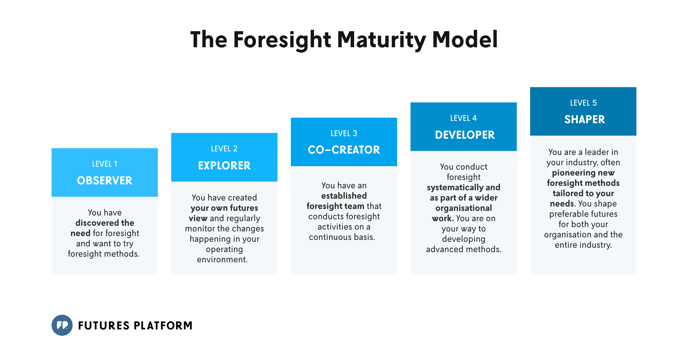Developed based on our strategic foresight consulting experience and academic research, the Foresight Maturity Model is a framework we use to assess where an organisation’s foresight capabilities currently are and how to develop them further.
Many organisations today understand the importance of being future-prepared. But without a coherent framework to guide them, they struggle to identify suitable methods, establish continuous foresight activities, and measure progress. To address this gap, Futures Platform’s team of strategic foresight consultants have developed our Foresight Maturity Model to help organisations understand where their foresight capabilities currently are and how to develop them further. In this article, we present the Foresight Maturity Model in detail.
Despite having similar targets, organisations' understanding and use of foresight vary based on where they are in their foresight journey. Some are just starting to grasp the concept, while others have already conducted some foresight activities. The most mature organisations have established systematic foresight routines and continuously seek novel approaches.
As strategic foresight consultants, we’ve observed that organisations often struggle to kick off their foresight activities, identify suitable methods, learn to use those methods in practice, and measure progress. The absence of a coherent framework to develop foresight capabilities prompted us to create a model that categorises and describes different stages of organisational foresight use. We named the final iteration of the model the Foresight Maturity Model, which is now at the heart of our consulting work.
Foresight maturity encompasses an organisation's total foresight activities. The more continuous, systematic, and competent in using the methods, the more mature the organisation is in terms of foresight. The model enables us to understand an organisation's current stage and identify the necessary steps to build its foresight capabilities.
“The absence of a coherent framework to develop foresight capabilities prompted us to create the Foresight Maturity Model, which is now at the heart of our consulting work. ”
THE BACKGROUND OF THE FORESIGHT MATURITY MODEL
We started developing the Foresight Maturity Model in 2020 based on our consulting experience and an academic perspective. "Corporate Foresight and its Impact on Firm Performance" by Rohrbeck, R., & Kum, M. E. (2018) and "Foresight Maturity Model" by Grim, T. (2009) were the two main articles that formed the foundation of our model. Eventually, a model structured around the basics of foresight emerged. Expanding outward from the core, much like the rings in a tree, the Foresight Maturity Model represents the development stages of foresight maturity in organisations.
The model's guiding principle is that the ideal state of foresight maturity for each organisation is defined by the volatility and complexity of the environment in which it operates. For instance, some organisations may thrive by occasionally conducting scenario exercises and continuously monitoring trends (Level 3), while those operating in more volatile contexts may need to engage in practical pilots and trials (Level 5) to gain a significant competitive advantage and become one of the top organisations in their industry.
5 LEVELS OF FORESIGHT MATURITY
The final Foresight Maturity Model has a sophisticated design that summarises the main differences between the levels, which are valid for both private and public organisations. The model is built around the resources and skills needed to achieve each level, and the base for foresight capabilities is built in levels 1 and 2.

At level 1, an Observer organisation has recognised the need for foresight and is testing methods with a selected group of colleagues. Typically, there’s only a handful of people within the organisation who see foresight as a crucial part of the organisational strategy. As a starting point, we usually recommend organisations to begin their futures exploration with horizon scanning.
At level 2, the Explorer organisation has defined the possible, probable and preferable futures based on changes in its environment. It also scans its operating environment from a broad perspective to identify change factors outside its industry. At this stage, the organisation is seeking suitable methods to use the results of its foresight work to stress-test its strategy and develop agile plans for “what if?” cases.
The Co-creator of level 3 has a dedicated foresight team that continuously works on foresight activities and is also responsible for involving other subject matter experts within the organisation in their foresight work. At this stage, the focus is on building frameworks and tools for increased foresight-related cooperation within the organisation and linking foresight results to other internal processes. Co-creator organisations usually receive support from external experts, such as futurists and consultants, to build these processes. More mature organisations also include external experts in their foresight workshops.
At level 4, the Developer organisation has their continuous foresight activities up and running. Foresight has become an integral part of planning and decision-making, and various teams across the organisation are knowledgeable about foresight. The foresight team conducts a wide range of foresight activities and is interested in learning new methods to further develop its capabilities. Some team members are responsible for active weak signal and trend scanning, while others scan for potential wild cards that may revolutionise what is perceived as “business as usual”. Those responsible for scenarios assist strategy teams across the organisation by building different scenarios to inform strategy processes. The board also utilises foresight in their work and regularly evaluates long-term opportunities when developing the vision and investment strategies.
Finally, at level 5, the Shaper is typically an industry leader, often in a monopoly position or a cross-national corporation with an innovative approach. In addition to their structured approach to doing foresight and utilising the results of foresight work in various internal processes, shapers also aim to develop novel foresight methods for their unique use cases. These tailored methods are difficult to replicate, giving the organisation a competitive edge. By embedding foresight at the core of their processes, Shapers become more agile and are well-positioned to shape the future of their entire industry.
TAKE A STEP TODAY AND START DEVELOPING YOUR FORESIGHT MATURITY
To effectively use the Foresight Maturity Model, it's important to first understand where your organisation currently stands and what your ambition level is. Don't expect to jump directly from level 1 to 5, as all the steps in between need to be taken. Our Foresight Maturity Model breaks down the development requirements for each level to help you plan for your yearly targets and determine the resources you need to succeed.
The good news is that we haven't seen organisations regress once they've progressed to a higher level. Even a small step forward can have a lasting impact, as long as there are people within your organisation who are committed to continuing the development of foresight. Without designated responsibility for foresight, however, progress can be challenging.
It's important to note that while there is a broad range of tools and methods available, real development comes when individuals start thinking proactively about the future. So, take the step to foster a culture of futures thinking in your organisation, and start working towards achieving the next stage of your foresight maturity today!
Want to find out what your foresight maturity level is?
We offer a free foresight audit for qualifying prospective customers. In an interview session with one of our foresight specialists, we go through a standard set of questions based on our foresight methodology to determine your current foresight maturity level and give you a list of practical advice on improving your foresight processes.
Ask more about the audit from your Customer Success Manager or contact us at support@futuresplatform.com.
ABOUT THE AUTHORS

Anna Grabtchak
Anna has been a senior consultant for over 10 years, and planned and led several strategy and foresight scenario projects. Today Anna is heading the service development at Futures Platform.

Max Stucki
Max works as the Foresight Analysis Manager at Futures Platform. He is responsible for supervising and developing the foresight analysis process. He has worked with numerous clients to help them prepare for the future.
References
Rohrbeck, R., & Kum, M. E. (2018). Corporate foresight and its impact on firm performance: A longitudinal analysis. Technological Forecasting and Social Change, 129, 105-116.
Grim, T. (2009). Foresight Maturity Model (FMM): Achieving best practices in the foresight field. Journal of Futures Studies, 13(4), 69-80.
